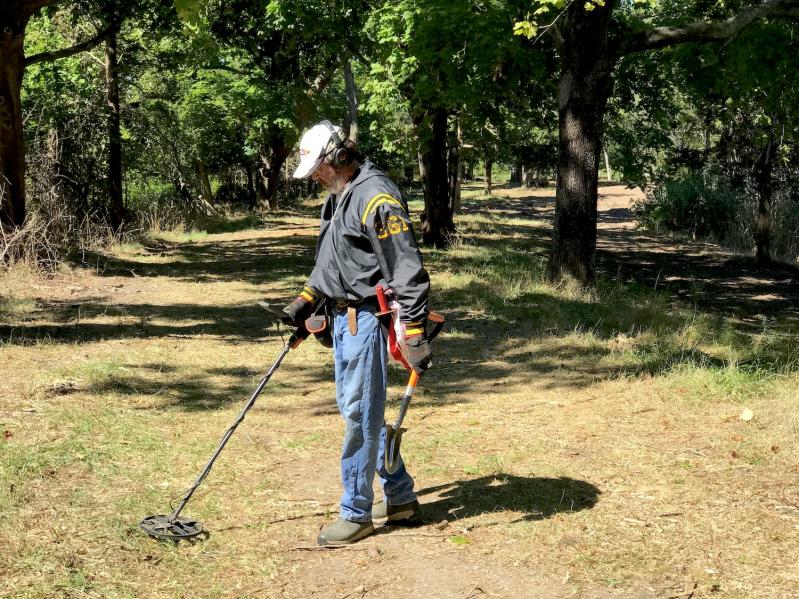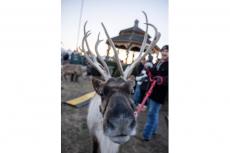“All metal detectorists are treasure hunters,” said Keith Douglas, a history-obsessed Bridgehamptoner.
At 6 feet 4 inches tall, sporting a long graying beard, and wearing beefy, over-the-ear headphones, knee-high rubber boots, a jumpsuit, and a belt with a shovel hanging off it, Mr. Douglas certainly looks like he’s searching for something.
Approaching retirement and in need of a hobby, he came across a metal detecting video on the internet that sparked his interest.
“The guy had a GoPro camera on his hat. You’re watching him swing the detector. Suddenly, he gets a hit, takes a shovel, digs the plug, and then the reveal!”
“It’s like giant scratch-off. You don’t know what’s underground until you dig the hole,” he said.
On a recent day, Mr. Douglas could be found with his detector in North Haven. “This was an old cart path, so you never know what you’re going to get,” he said. A faint beeping could be heard through his headphones as the detector passed over the ground. “Could be garbage,” he said. He pulled a spade shovel from his belt and dug a small hole. He got down on his knees and hovered with what looked like a large highlighter — actually a very sensitive tool called a pinpointer — just above the hole.
The pinpointer beeped, confirming he was close to a find. He put the shovel away and took out a lesche, a smaller spade-like tool that’s typically used for gardening, and worked it into the hole. Seconds later he held up a dirty, unrecognizable lump.
“Shotgun shell,” he said, dropping it into a collecting bag that hung off his opposite hip. He regrouped and began slowly walking and swinging onto the next find.
Metal detectorists come in two main varieties, said Brian Micari, who has been detecting for the last eight years and sells equipment through his website lidetectingresource.com.
“A lot of people see the old guys who are working the beach, looking for lost jewelry. That may be the popular impression of the detectorist, but they don’t see the guys or ladies in the middle of the woods,” he said. “I’m more into the history of it. Half the fun is finding something. The other half is trying to research how old it is and figuring out who was in the area at the time.”
“Best thing I found was a button belonging to the King’s American Dragoons. Only eight of these have ever been found. To find something like that on Long Island, it’s crazy. A lot of people don’t think of all the history here,” he said.
The Dragoons were loyal to the British and served on Long Island in 1782 and 1783.
Along with a British TV show “The Detectorists,” social media is partly responsible for the resurgence in metal detecting. “There’s a guy on the Island who posts his finds on Facebook,” said Mr. Micari. “All Revolutionary War stuff. His posts generate hundreds of comments.”
But no one would ever post the exact location of their finds.
“You don’t reveal that information,” said Mr. Micari. “Especially if it’s a permission. People would flock there and start searching.”
A “permission” describes a private piece of land on which a detectorist has been granted permission from the owner to search. Mr. Douglas is quite good at receiving permissions, a skill he attributes to his past as a software salesman in the 1980s and 1990s. “I’m always ready for a ‘no,’ “ he said.
Most of the places he’s received permissions for are owned by friends of friends. “I’m looking for old colonial home sites. The first question people ask is, ‘What are you looking for?’ The answer is, ‘I’m looking for anything that depicts the history of Long Island,’ “ said Mr. Douglas.
“Then I tell them some of the things I’ve found at other homes.”
His best finds? A King George II penny, a King George III penny, a musket ball, the quintessential pioneer’s ax, and a half-dime, “Only as big as your pinky nail,” he said.
Before Ralph Dayton sold his land adjacent to Herrick Park to the Town of East Hampton to be preserved as an arboretum, he let Mr. Douglas detect there. He found an old Montauk Fire Department badge next to an ancient Chinese coin. It moves the imagination: just below the surface of the soil, worlds collide.
“I was just excited to see what he found,” said Mr. Dayton.
Mr. Douglas also swung his detector on a Sag Harbor property owned by Virginia Long, with a house built in 1891 and occupied by her family since the 1950s. “Behind the house was a road called Roses Lane,” said Ms. Long. “That’s where all the vendors would sell their wares, horse and buggy stuff,” she said. “Keith found some old coins, going back to the 1700s. Even before the Meigs Expedition.”
The Meigs Expedition or Raid, also known as the Battle of Sag Harbor, took place in the spring of 1777. A plaque commemorating it sits at the intersection of Long Beach and Noyac Road.
“It gave me a richer understanding of our property,” she said.
The hobby has enriched Mr. Douglas’s imagination too. He wonders about the old farms out here. “The Halseys, the Toppings — what were their interactions with the British? Were they loyalists or colonialists? The British would come and take over people’s farms . . . “ he said, trailing off.
If detecting is about digging up the history of the East End, it’s also about digging up a lot of trash. Bottle caps, lead sheeting, copper sheeting, square nails. “Buckets and buckets that I have to throw out,” said Mr. Douglas.
For others it’s just another way to be outside. “I’m pretty casual about it,” said Kyle Sanderson, owner of Grindstone Donuts in Sag Harbor. “It’s an adjacent activity to hiking. It feels kind of like birdwatching, there’s a hunting element to it. Exploration.”
Mr. Sanderson said on the East End, the only designated places where you’re allowed to detect are Cedar Point and Montauk County Park.
“I like finding anything, really. I like finding weird shit no matter where I am,” he said.
Other tools of the detectorist are a small squeeze bottle of water, a toothbrush, and a rag to clean the items for display. Mr. Douglas has his splayed out on a table in his basement. Mr. Sanderson keeps a shadow box in his living room with his best finds. Mr. Micari says some detectorists will even consign their finds to a local historical society.
“I also found this little copper container,” said Mr. Douglas, as if telling a secret. “A tiny copper container that I thought was an old fuse. I was fiddling with it and out popped a Madonna and Child. An inch tall.”
Treasure!




